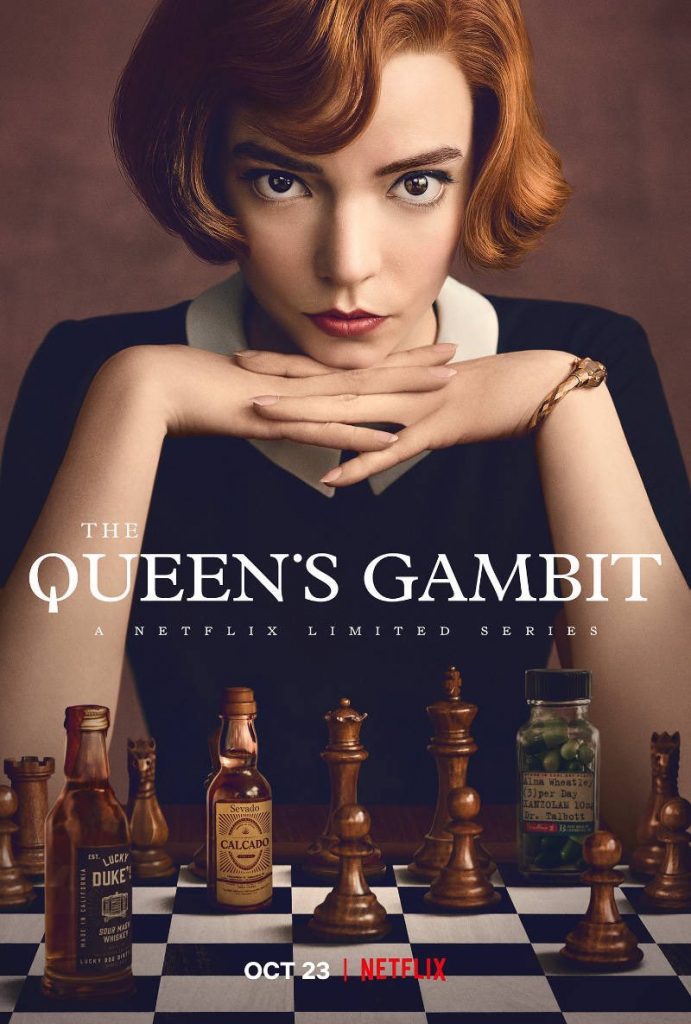The Queen's Gambit
INTRODUCTION
They often say “Creativity and psychosis go hand in hand”. The captivating 7-part Netflix miniseries from Scott Frank & Allan Scott quite revolves around that idea. Diving deep into complex feminist themes with clear indication of literary influences from around the world, The Queen’s Gambit declares its own conception about triumph & what it means to be empowered, all the while fighting against the very own demons inside. The cinematic adaptation of the 1983 novel of the same name by Walter Tevis, a period piece about a convoluted orphan girl who is proficient at the intellectual game of chess, is not something very unpredictable, but the elegance and pure craftsmanship shown in storytelling is what makes it an absolute binge-worthy material.
Story and Setting
Following the trail of the kind of tales where children having buried traumas evolve into the greatest champs in their own fields, it’s the story of Beth Harmon- an impassive orphan with a Christian upbringing, and how she transforms into one of the greatest chess player of her time, cooking strategies and winning matches against grandmasters. We see her arriving at the stern Methuen Home for Girls in Lexington Kentucky with a certain nonchalance in her eyes when she is eight. Reminiscing about her dead mother every now and then, she soon grows an addictive inclination towards chess after befriending the foundling home’s lone janitor, Mr. Shaibel, who takes her under his wing and is, within no time, completely astounded by her genius mind. Beth is often found cocooned in her own world with a tremendous dependence on drugs from childhood, envisioning the chess pieces on the ceiling moving of their own accord – her only companions being the book “Modern Chess Openings” and the black fellow dweller Jolene. By the beginning of the second episode, we find her being adopted by an unhappy couple to a house in the suburbs and as she struggles to fit into a new life, fate reunites her with chess once more. Over the next few years we witness the fascinating story which involves her winning local tournaments to being America’s first challenger against the Soviets.
Speaking of screenplay
Although the pace of the show seems slow at a couple of places, there is not a single minute wasted. The exquisite set design & period perfect locations, punched with long shots and brief pauses set the mood for a tight prestige drama. Moreover, former World Chess Champion Garry Kasparov and chess coach Bruce Pandolfini have been ideal accession as consultants, adding almost painful authenticity to each scene where the chess tournaments are conducted. The correctly oriented board pieces, right hand movement of the players, and detailing of the competition scenes show exactly how much effort goes behind one successful series.
PERFORMANCES & DIRECTION
We know Anya Taylor-Joy is the all hailed star of the show. We discover that Beth has a silent fire inside her. She is not afraid to be alone, and although she loves to win, it is admitted by her that “chess isn’t always competitive, chess can be beautiful”. Anya plays this character with utmost care – being ruthless as if Beth was born to rule when she sits in front of a chessboard, her long fingers picking up the pieces and thrashing opponents’ confidence – or being vulnerable at the sight of her romantic interest so much so that she loses all her composure – while at the same time exhibiting every trait of a highbrow having an extremely self-destructive nature. Anya shines in every shot. Bagging Golden Globes is just the perfect recognition for the woman who embodied this difficult character arc effortlessly. She is aided by an excellent ensemble cast of supporting characters, who play crucial roles in shaping Beth as a champion. The chemistry between Beth and her foster mother, Alma Wheatley, played by an impeccable Marielle Heller, who cannot comprehend Beth’s intelligence and yet is her biggest cheerleader, is unbelievably heartwarming and fun to watch. Adding to it, the performances of Thomas Brodie-Sangster and Harry Melling as chess enthusiasts who are allured by Beth’s skill are not only treat to the eyes but add so much more to the script. Jacob Fortune-Lloyd, the journalist chess player who is also Beth’s love interest, and Bill Camp as Mr. Shaibel have criminally short screen times but we see wonder within those few minutes!
What surprises a lot is the fact that we learn about Sicilian defense, even the Najdorf variation, the concepts of adjournment and Marshall attack, but not for once feel overwhelmed. The directorial brilliance ensures no disconnection of the audience from the sharp plot. So does costume designer Gabriele Binder’s subtle yet on point mid-sixties costumes which continuously evoke the idea of a chessboard in your mind. Brilliant touch!!
Special Mention
To my greatest delight, The Queen’s Gambit, instead of becoming just a tale of chess and victory, is a brilliant scope of character sketch and an empathetic account of one oddball character, who over the years, unknowingly makes many humane connections. Connections which mould her into what she is. For instance Mr. Shaibel was that person who could not only understand Beth’s masterful mind but was also the father figure she never had in her life. Their short, fine-drawn dynamics and ultimate closure will surely leave you pensive. So will the relation between Alma & Beth. I mean, how beautiful it is to see one troubled woman understanding and having the back of another, even when she doesn’t need to anymore! There’s a subtle treatment of racial differences as well pertaining to Beth’s friend Jolene, which is handled skillfully enough. For all these reasons and much more, this limited series is the one that I find hugely impactful.
CONCLUSION
A show so perfect like this releases rarely. It surely is Netflix’s trump card. As we see Beth Harmon on her path towards greatness, gradually discarding the idea that chess requires monastic isolation, embracing life & human company once more, we surely are in love with this awe-inspiring tale! It’s something which you’ll definitely want to revisit time & again, one which will raise nothing but more admiration.
Disclaimer: The above review solely illustrates the views of the writer.




